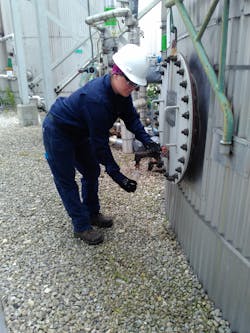BASF Apprenticeship Program Hits the Right Note
When BASF, the world’s largest chemical producer, advertised last year for applicants to enroll in its North American Apprenticeship Development Program (NAADP) located in Wyandotte, Michigan, over 200 people applied. That’s a strong number, especially when you consider there were only 10 spots available.
What does BASF know that other manufacturers need to learn?
“Attracting talent to an apprenticeship program starts first with a mindset shift. If you are stuck in the thinking that you can only bring someone into the company that has experience or specific industry certification, you are setting up unnecessary blocks,” explains Jonathan Weatherly, vice president of operations for BASF’s Performance Materials business. “Instead, you should be asking, how do you teach someone a skill. While having an education is important, it’s really the on-the-job training that provides the competence.”
On May 31 the company announced it was expanding its program and now has almost 100 apprentices at 20 manufacturing sites across the country. This year, multiple sites were added including White Stone, South Carolina; Whitehouse, Ohio; and Huntsville, Alabama.
BASF has been in the apprenticeship business for a long time. “Globally, BASF has a history of offering apprenticeship opportunities for more than 100 years,” said Michael Heinz, Chairman, and CEO of BASF Corp. said in a statement. “In the U.S., we are committed to building on this success and expanding this entry option into industry while further strengthening our diverse and skilled workforce. I am convinced of the great value vocational training provides as an important first step to a successful career at BASF.”
Vocation Training 2.0
Vocation training is a term that might not be familiar to everyone, but it’s been around a while. “A generation ago in North America, there were many vocational programs,” notes Weatherly, who is the sponsor of the NAADP. “We aren’t creating something new, but we are expanding its original scope, which focused on electricians and welders, into production jobs. Over the past few years, bringing people into the industry has been an even harder struggle.”
Why? Perception of the industry still seems to be the largest barrier. “We like to bring potential employees into our plant to show them it’s not the dirty, dark and dangerous place that they might think it is. It’s now a clean, safe and good working environment.” And that message does seem to be breaking through as much of the interest in the company’s apprenticeship program came from social media.
The company cast a wide net for applicants which aligns with their openness to candidates who are new to the industry but have the desire to learn new skills and see the opportunities that BASF provides. One of the opportunities important to potential employees is career paths. These paths can include moving up in the organization, moving across the company, or tackling new skills. And these considerations need to be front and center when planning an apprenticeship program, advises Weatherly. “Consider how you want to build your workforce and create a training cycle that works within your company. It’s a win-win situation as you are bringing in talent that is doing the work, alongside trained employees, and that person is receiving tuition-free education.”
At the end of the training, which can last anywhere from 12-36 months, apprentices earn an industry-recognized certificate or associate degree. While the company requires apprentices to stay for two years after receiving their certification, looking across the entire company, around 90% become permanent employees.
Perhaps the key to high retention rates is the quality of the education that apprentices receive. The company is currently collaborating with 20 local colleges across the country to ensure comprehensive and integrated training. “It’s our strong partnership with education institutions that is essential to students receiving the exact training that is needed to work at our plants. In working with education systems we use some programs that are already developed, and we also help develop programs that address the unique requirements of our plants. It’s a continual improvement process as we use feedback loops to tweak and enhance programs.”
A Bright and Diverse Future
In addition to ensuring an updated curriculum, the company sought to improve the diversity of its candidates and future employees. “Our goal is that the inside of our plant should look like the outside of our plant.” And that is happening, as the company’s 2022 roster of new apprentice hires includes an average 44% female selection rate. This aligns with the company’s corporate goal of having women in 30% of the production, maintenance and utility roles by 2030.
Part of the high rate of attracting women is the company’s FLAME (Female Leaders Advancing Manufacturing Excellence) program that started in non-production roles but is moving into production roles. “We have asked women to pay it forward and become mentors to other women. This mentorship is especially important when recruiting women as potential candidates as they can see someone who looks like them in a variety of roles and then can envision themselves in these roles.”
BASF is confident that as these apprenticeship programs grow and the word spreads about their value, they can create a healthy talent pipeline. As the current generation is looking for careers, Weatherly feels BASF offers them a lifetime of learning. “Choose your own adventure, I tell them.”

